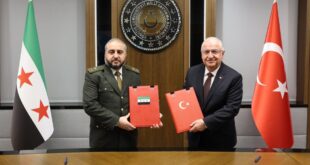(Reuters) – The U.S. military said on Wednesday the last of five extra combat brigades deployed to Iraq last year would complete its departure next week. That will leave 140,000 troops in Iraq. Following are facts about the so-called surge:
WHY WERE EXTRA TROOPS SENT?
President George W. Bush ordered the deployment in January 2007 to stop Iraq sliding into sectarian civil war. The bombing of a Shi’ite shrine in the city of Samarra in February 2006 had triggered intense fighting between majority Shi’ites and minority Sunni Arabs. Al Qaeda militants had also sought to fan the tensions, stepping up a campaign of car bombings. Five combat brigades plus supporting troops, or some 30,000 soldiers, were sent to Iraq between February and mid-June 2007. Besides reducing violence, Washington wanted to create “breathing space” for Iraqi leaders to make progress on laws seen as critical to fostering national reconciliation.
HOW WAS THE “SURGE” IMPLEMENTED?
Most reinforcements were deployed in and around Baghdad, the epicenter of the sectarian violence. General David Petraeus, newly appointed commander of U.S. forces in Iraq, focused on counterinsurgency tactics. Troops were ordered out of large bases into small outposts to live and fight with Iraqi forces. This spread a security footprint into Baghdad’s most dangerous districts. Another goal was to clean out Baghdad’s “beltways”, areas around the capital where al Qaeda assembled many of its car bombs. Emphasis was also placed on reviving local government and the economy. Militants put up tough resistance. From April to June 2007, 331 U.S. soldiers were killed, the deadliest quarter of the war for the U.S. military.
WHAT DID IT ACHIEVE?
U.S. officials say it helped cut violence to four-year lows. A decision by Sunni Arab tribal leaders to turn against al Qaeda in late 2006 and a ceasefire by Shi’ite cleric Moqtada al-Sadr, whose Mehdi Army was blamed for much of the sectarian killing, also helped sharply reduce violence. U.S. forces joined largely Sunni Arab tribal security units, many comprising former insurgents, to squeeze al Qaeda out of their strongholds in Baghdad and western Anbar province. A key element of Petraeus’ strategy was to protect neighborhoods and markets. This led to the construction of concrete walls around many areas of Baghdad, which sometimes sparked controversy.
WHAT DID NOT GO RIGHT?
During 2007, there was little progress on reconciliation. The main Sunni Arab bloc quit the government in a row over power sharing and has not returned. Most key laws that Washington wanted passed, foundered. A few laws have been passed this year, but implementation has been patchy. Perhaps the most important piece of legislation, a draft law to divide the country’s vast oil reserves equitably among Iraq’s ethnic and sectarian groups, remains deadlocked. Provision of government services has also languished. Iraqis who once complained about security now moan about electricity and water shortages, long queues at petrol stations and a lack of jobs.
WHAT HAPPENS NEXT?
All eyes will be on Petraeus, who is expected to make recommendations on future U.S. troop levels to the U.S. Congress in September. The New York Times has reported the Bush administration was already considering more troop cuts beginning in that month. On Monday, Petraeus said security conditions would determine his recommendations. At the same time, Iraqi Prime Minister Nuri al-Maliki has suggested a timetable be set for the departure of U.S. troops from Iraq as part of talks with Washington over a new security deal.
 Eurasia Press & News
Eurasia Press & News



